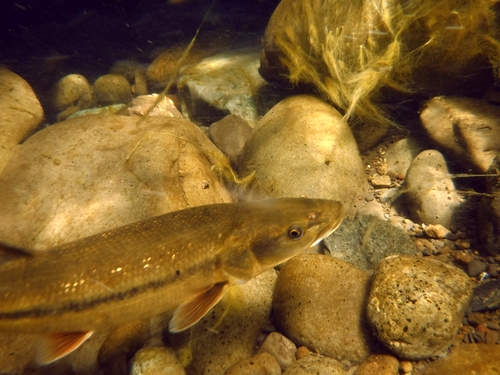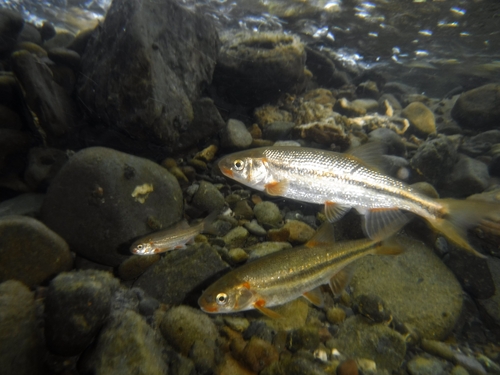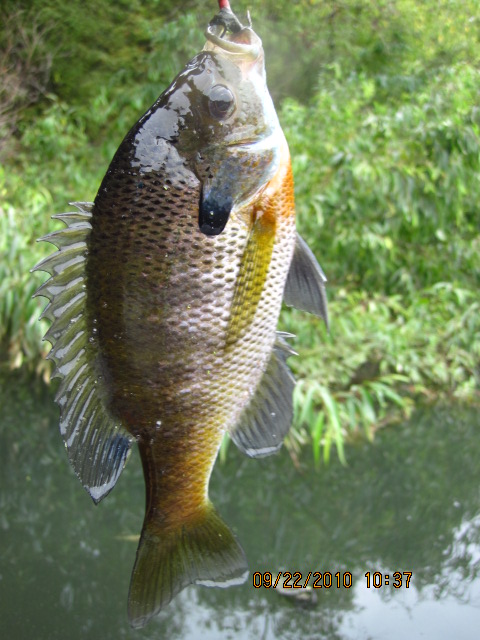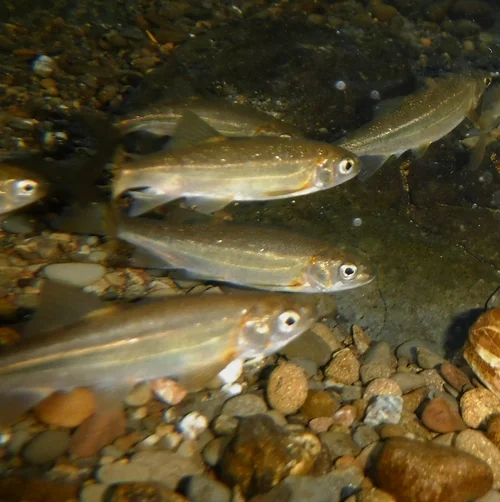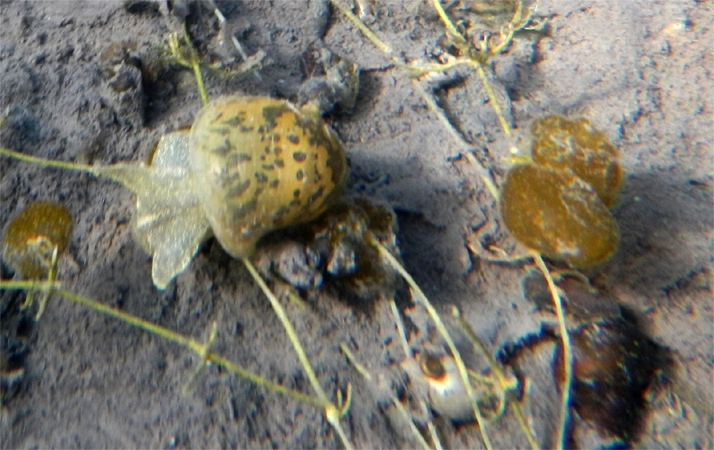Non-Native Aquatic Species
The Eel River is profoundly changed from its historic condition, which makes it more susceptible for non-native fish species to proliferate and in the case of one to rise to dominance. The Sacramento pikeminnow gets a lot of attention from ERRP because it predates on native fish and has spread to most areas of the basin not blocked by waterfalls. Other exotic fish species escape from ponds and may take over warm pools as creeks dry up and may also flourish in main river environments during prolonged drought. Two non-fish species of note are also discussed below, the bullfrog and a snail because of their significant impacts .
Sacramento Pikeminnow
This is the largest minnow native to North America. Its large mouth and voracious feeding habitats gave rise to its name. It loves warm water, with a thermal optimum of 82 F, well over the lethal range for salmonids. It was introduced from Clear Lake or Cache Creek into Pillsbury Reservoir and spread throughout the Eel River basin by 1986. Pikeminnow came to dominate Eel River main channels during the 1986-1992 drought, threatening native fish species.
Watershed residents urged ERRP to help monitor the species and to control it, if possible, to limit predation of salmon and steelhead. Since 2016, we have been monitoring an index reach on the South Fork Eel stretching from Rattlesnake Creek to Standish Hickey State Park because it is an area of known predation on juvenile steelhead.
The abundance of pikeminnow is greatly reduced from levels in the early 1990s and it appears that otter predation has them concentrated in deep pools and around large wood. We have collected three years of baseline data, which confirmed our hypothesis that large pikeminnow are concentrated in pools. We want to continue to collect trend data, but also to experiment with removal of large adults to reduce predation and lessen reproductive capacity of the population. Native salmon and steelhead would benefit as well as other native species.
Read reports: 2016; 2017; and 2018.
See more video (https://vimeo.com/203137323) and (https://vimeo.com/226949852)
California Roach
This warmwater species is thought to be introduced in the Eel River basin. It is very fecund, giving rise to several broods per year. Population doubling time is estimated at 15 months, which makes the roach extremely resilient. Adults are golden in color with a forked tail and may attain a size of 5 inches in length. It is shorter and stouter than pikeminnow and can also be distinguished by the lack of a purple stripe on its side. While steelhead juveniles may dominate tributaries during high flow periods, roach become the more numerous species as Eel River tributaries drop and warm.
Green sunfish
Native to the Mississippi River basin, green sunfish and their cousins the bluegill are popular fish to raise in ponds. They are often planted in combination with largemouth bass that use them as part of their forage base. Sunfish spawning in small gravel in isolated pools in Tenmile Creek during summer and may become numerous and spawn in main river environments in drought years. Since they are adapted to quiet waters, they are washed to the ocean with any high water event.
Bullhead
The bullhead or catfish is also a Mississippi River basin fish and is also imported and planted in ponds. They are good to eat, but are not well adapted to the swift waters of the Eel River and do not survive high water conditions. Juvenile catfish feed by swarming over shallow areas consuming plant matter, flocculent material and small invertebrates. Adult catfish swim around and through the school of small fish to guard against predation.
Shad
Native to the East Coast, shad were introduced into San Francisco Bay in the 1890’s. They are anadromous and their juveniles spend very little time in freshwater. They colonized the Eel River and can vary widely in abundance from year to year. Anglers love to fly fish for them. They do not compete with salmon and steelhead so their introduction has had very little ecological impact.
Striped Bass
Striped bass with Chinook in lower Eel River
The striped bass was also introduced into San Francisco Bay in the late 1800s and became well established there. They like to spawn in brackish water near the top of the inter-tidal zone and are not known to spawn in the Eel River. However, striped bass are wanderers and show up in the Eel River to forage in fall sometimes migrating as far upstream as Dyerville. There are often schools of young adult fish 16-20 inches in length that anglers call “schoolies”.
Bullfrog
This non-native frog species can grow to be 6-8 inches in length and weigh up to more than a pound and a half. Planted in ponds throughout the Eel River basin, this species can take over flow depleted streams proliferating in pools and colonizing other ponds up to a mile away from the stream. Like warmwater exotic fish, this species can become more well established in main river channels during droughts.
Radix auricularia
This snail was introduced to the Eel River likely imported by accident on vegetation used in ponds. Originally native to Eastern Europe, it was introduced into the U.S. in the Hudson River in New York in the late 1800s and colonized rivers of the upper Mid-West by the 1920s after migrating through canals. It can trap air in its shell and float downstream to colonize. Fish diseases and swimmer’s itch use snails as an intermediate host so increasing snail populations can increase these afflictions.

